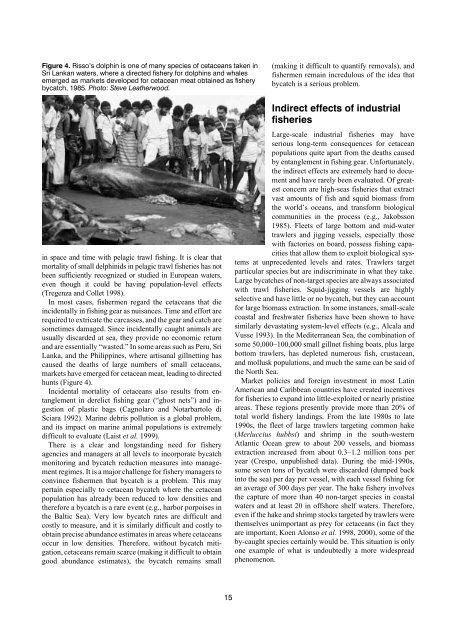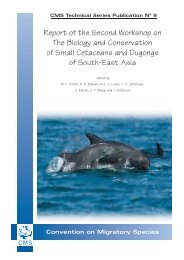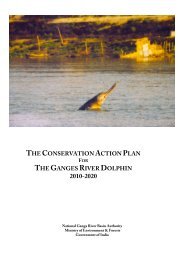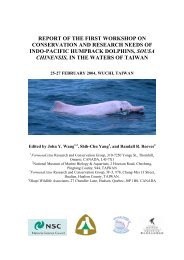Dolphins, Whales and Porpoises: 2002-2010 Conservation - IUCN
Dolphins, Whales and Porpoises: 2002-2010 Conservation - IUCN
Dolphins, Whales and Porpoises: 2002-2010 Conservation - IUCN
Create successful ePaper yourself
Turn your PDF publications into a flip-book with our unique Google optimized e-Paper software.
Figure 4. Risso’s dolphin is one of many species of cetaceans taken in<br />
Sri Lankan waters, where a directed fishery for dolphins <strong>and</strong> whales<br />
emerged as markets developed for cetacean meat obtained as fishery<br />
bycatch, 1985. Photo: Steve Leatherwood.<br />
(making it difficult to quantify removals), <strong>and</strong><br />
fishermen remain incredulous of the idea that<br />
bycatch is a serious problem.<br />
in space <strong>and</strong> time with pelagic trawl fishing. It is clear that<br />
mortality of small delphinids in pelagic trawl fisheries has not<br />
been sufficiently recognized or studied in European waters,<br />
even though it could be having population-level effects<br />
(Tregenza <strong>and</strong> Collet 1998).<br />
In most cases, fishermen regard the cetaceans that die<br />
incidentally in fishing gear as nuisances. Time <strong>and</strong> effort are<br />
required to extricate the carcasses, <strong>and</strong> the gear <strong>and</strong> catch are<br />
sometimes damaged. Since incidentally caught animals are<br />
usually discarded at sea, they provide no economic return<br />
<strong>and</strong> are essentially “wasted.” In some areas such as Peru, Sri<br />
Lanka, <strong>and</strong> the Philippines, where artisanal gillnetting has<br />
caused the deaths of large numbers of small cetaceans,<br />
markets have emerged for cetacean meat, leading to directed<br />
hunts (Figure 4).<br />
Incidental mortality of cetaceans also results from entanglement<br />
in derelict fishing gear (“ghost nets”) <strong>and</strong> ingestion<br />
of plastic bags (Cagnolaro <strong>and</strong> Notarbartolo di<br />
Sciara 1992). Marine debris pollution is a global problem,<br />
<strong>and</strong> its impact on marine animal populations is extremely<br />
difficult to evaluate (Laist et al. 1999).<br />
There is a clear <strong>and</strong> longst<strong>and</strong>ing need for fishery<br />
agencies <strong>and</strong> managers at all levels to incorporate bycatch<br />
monitoring <strong>and</strong> bycatch reduction measures into management<br />
regimes. It is a major challenge for fishery managers to<br />
convince fishermen that bycatch is a problem. This may<br />
pertain especially to cetacean bycatch where the cetacean<br />
population has already been reduced to low densities <strong>and</strong><br />
therefore a bycatch is a rare event (e.g., harbor porpoises in<br />
the Baltic Sea). Very low bycatch rates are difficult <strong>and</strong><br />
costly to measure, <strong>and</strong> it is similarly difficult <strong>and</strong> costly to<br />
obtain precise abundance estimates in areas where cetaceans<br />
occur in low densities. Therefore, without bycatch mitigation,<br />
cetaceans remain scarce (making it difficult to obtain<br />
good abundance estimates), the bycatch remains small<br />
Indirect effects of industrial<br />
fisheries<br />
Large-scale industrial fisheries may have<br />
serious long-term consequences for cetacean<br />
populations quite apart from the deaths caused<br />
by entanglement in fishing gear. Unfortunately,<br />
the indirect effects are extremely hard to document<br />
<strong>and</strong> have rarely been evaluated. Of greatest<br />
concern are high-seas fisheries that extract<br />
vast amounts of fish <strong>and</strong> squid biomass from<br />
the world’s oceans, <strong>and</strong> transform biological<br />
communities in the process (e.g., Jakobsson<br />
1985). Fleets of large bottom <strong>and</strong> mid-water<br />
trawlers <strong>and</strong> jigging vessels, especially those<br />
with factories on board, possess fishing capacities<br />
that allow them to exploit biological systems<br />
at unprecedented levels <strong>and</strong> rates. Trawlers target<br />
particular species but are indiscriminate in what they take.<br />
Large bycatches of non-target species are always associated<br />
with trawl fisheries. Squid-jigging vessels are highly<br />
selective <strong>and</strong> have little or no bycatch, but they can account<br />
for large biomass extraction. In some instances, small-scale<br />
coastal <strong>and</strong> freshwater fisheries have been shown to have<br />
similarly devastating system-level effects (e.g., Alcala <strong>and</strong><br />
Vusse 1993). In the Mediterranean Sea, the combination of<br />
some 50,000–100,000 small gillnet fishing boats, plus large<br />
bottom trawlers, has depleted numerous fish, crustacean,<br />
<strong>and</strong> mollusk populations, <strong>and</strong> much the same can be said of<br />
the North Sea.<br />
Market policies <strong>and</strong> foreign investment in most Latin<br />
American <strong>and</strong> Caribbean countries have created incentives<br />
for fisheries to exp<strong>and</strong> into little-exploited or nearly pristine<br />
areas. These regions presently provide more than 20% of<br />
total world fishery l<strong>and</strong>ings. From the late 1980s to late<br />
1990s, the fleet of large trawlers targeting common hake<br />
(Merluccius hubbsi) <strong>and</strong> shrimp in the south-western<br />
Atlantic Ocean grew to about 200 vessels, <strong>and</strong> biomass<br />
extraction increased from about 0.3–1.2 million tons per<br />
year (Crespo, unpublished data). During the mid-1990s,<br />
some seven tons of bycatch were discarded (dumped back<br />
into the sea) per day per vessel, with each vessel fishing for<br />
an average of 300 days per year. The hake fishery involves<br />
the capture of more than 40 non-target species in coastal<br />
waters <strong>and</strong> at least 20 in offshore shelf waters. Therefore,<br />
even if the hake <strong>and</strong> shrimp stocks targeted by trawlers were<br />
themselves unimportant as prey for cetaceans (in fact they<br />
are important, Koen Alonso et al. 1998, 2000), some of the<br />
by-caught species certainly would be. This situation is only<br />
one example of what is undoubtedly a more widespread<br />
phenomenon.<br />
15





